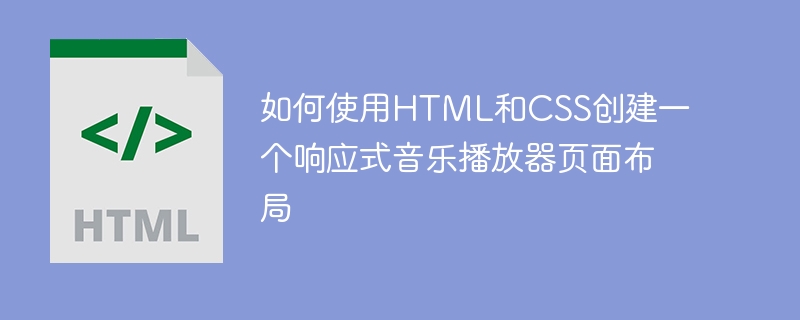

How to use HTML and CSS to create a responsive music player page layout
The development of the Internet has made music players an indispensable part of people's lives. HTML and CSS are indispensable tools when it comes to creating an excellent music player page layout. This article will introduce how to use HTML and CSS to create a responsive music player page layout, and give specific code examples.
First, we need to create an HTML document and define the basic structure of the page. The following is an HTML code example for a simple music player page layout:
<!DOCTYPE html>
<html>
<head>
<title>响应式音乐播放器</title>
<link rel="stylesheet" type="text/css" href="style.css">
</head>
<body>
<div class="container">
<header>
<h1>我的音乐播放器</h1>
<!-- 一些其他的音乐播放器控制按钮 -->
</header>
<main>
<div class="player">
<div class="player-info">
<!-- 音乐封面、歌手和歌曲信息 -->
</div>
<div class="player-controls">
<!-- 播放/暂停按钮、上一曲/下一曲按钮、音量控制按钮等 -->
</div>
<div class="progress-bar">
<!-- 进度条和当前播放时间/总时长 -->
</div>
</div>
<div class="playlist">
<!-- 音乐播放列表 -->
</div>
</main>
<footer>
<p>版权信息</p>
</footer>
</div>
</body>
</html>In this code example, we use semantic HTML tags to define the basic structure of the page, such as <header> ;, <main>, <footer>, etc. We also linked a CSS style sheet named style.css in the <link> tag.
Next, we need to create a CSS style sheet named style.css and define the style of the page. The following is a simple CSS code example:
/* Reset CSS */
html, body, h1, div, p, header, main, footer {
margin: 0;
padding: 0;
border: 0;
}
.container {
max-width: 800px;
margin: 0 auto;
padding: 20px;
}
header {
background-color: #333;
color: #fff;
padding: 20px;
text-align: center;
}
header h1 {
font-size: 24px;
}
.player {
text-align: center;
padding: 20px;
}
.player-info {
margin-bottom: 20px;
}
.player-controls {
margin-bottom: 20px;
}
.progress-bar {
margin-bottom: 20px;
}
.playlist {
background-color: #f4f4f4;
padding: 20px;
}
.footer {
background-color: #333;
color: #fff;
padding: 20px;
text-align: center;
} In this code example, we use some basic CSS properties to define the style of the page, such as background-color, color, padding, etc. We also use some layout-related attributes, such as text-align, margin, and padding, to implement the layout of the page.
In order to adapt the layout of our music player page to different screen sizes, we need to add some media queries and responsive design code. The following is a simple CSS code example for responsive design:
/* 在 600px 宽度以下的屏幕上隐藏播放列表 */
@media (max-width: 600px) {
.playlist {
display: none;
}
}
/* 在 768px 宽度以下的屏幕上将音乐播放器居左 */
@media (max-width: 768px) {
.player {
text-align: left;
}
} In this code example, we use the @media rule to define styles for different screen sizes. On screens up to 600px wide, we hide the playlist; on screens up to 768px wide, we center the music player to the left.
Through the above steps, we have completed a simple responsive music player page layout. You can further refine and customize this page layout to your needs and add more features and interactions. Hope this article is helpful to you!
The above is the detailed content of How to create a responsive music player page layout using HTML and CSS. For more information, please follow other related articles on the PHP Chinese website!